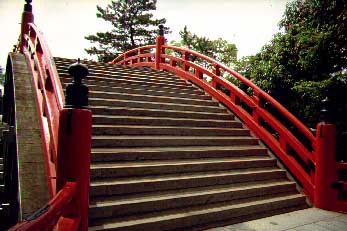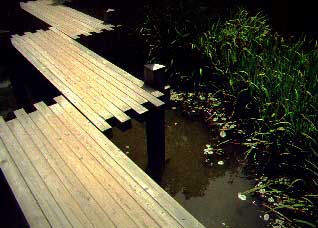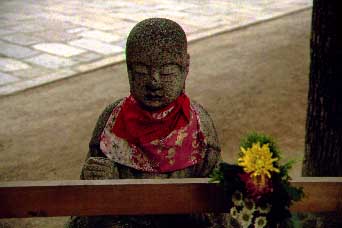

![]()

OK...so what, I went to Japan to photograph
a pair of
'Wellies' on a corrugated roof, is that a
problem...
...by the way, when do I get the money ???

I
really liked this house, it's somewhere in Kyoto and
it's got this funny look !!!

Let's see, what can I say about this...well
nothing much
really, it just looks great, doesn't it
?

I called this photo 'shiawase'
because it means good luck
and that's what it really is all about, make your wish, write
it on a piece of paper (or wood) and then tie it in a tree
or on a special stand in a temple.

The 'Sumiyoshi
Taisha Shrine' and it's "Taiko-hashi"
arched bridge, try crossing the bridge when
holding
a video-camera and looking through the viewfinder
!!
(Osaka 1993)

A 'Yatsuhashi' as featured in a
number of classic
Ukiyo-E woodblock prints...don't remember where
I took this
picture...though..


These two pictures are of "Jizo"
statues and I took these photos because they not only looked good, I found
these sculptures very moving - they have this sad mood which hangs over them -
If I correctly remember both are in 'ShiTennoji Temple'
(Osaka) grounds.
The story goes like
this: "...The Japanese believe that children
who have died go on to the "Dry Bed of the Soul River".
This is a desolate place without any sunlight, with bleak mountains that rise
against a pale sky and dark valleys.
Nothing grows on this barren soil, no trees, no flowers, no grass, nothing.
The souls of the deceased children walk on barefeet over the rough boulders
along the river's edge. These poor
souls think about their brothers and sisters, left behind on the warm earth and
they cry like nobody has ever heard
upon this world. Then, 'Jizo' comes to them. He laughs tender and lovingly to
the children.
He cherishes
and comforts the children like their mothers once did and pats them on the back
like a loving father.
All day long, the soul of the children crowd him and they don't feel
abandoned anymore.
His luminiscent gown sheds some light in the gloom. Under his supervision the
(soul)children built small hills (stupa) of boulders these stupa represent
prayers, one for their faher, one for their mother and one for their brothers
and sisters. Thus the time passes and the (soul)children get used to it.
'Jizo' a
boddhisattva is the compassionate patron of children, pregnant women an
travelers. The statuary representing
'Jizo' sometimes differs, but the classic example looks like a shaven-headed
priest holding a precious stone in one hand
and a staff decorated with three metal rings in the other.
It's not uncommon to find hundreds of tiny 'Jizo' adorned with a red bibs and
berets lining the pathways leading to temples. heaped around 'Jizo' will be
piled heaps of stones. Compassionate people place them there to aid the release
of children's souls who are doomed to pile stones along the banks of
'Sai-no-Kawara', the river of Hell.
The last paragraph comes from J.D. Bisignani author, traveler of the "Japan Handbook"™
previous